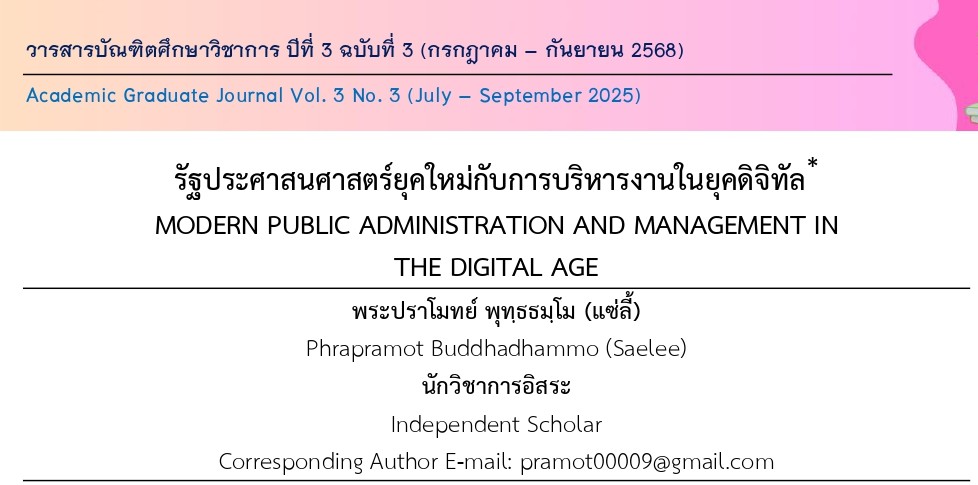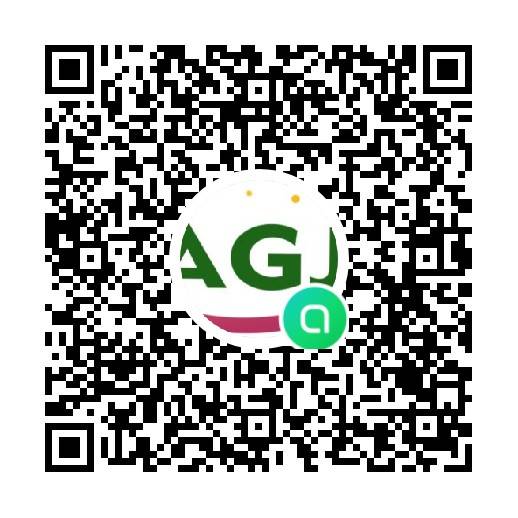รัฐประศาสนศาสตร์ยุคใหม่กับการบริหารงานในยุคดิจิทัล
คำสำคัญ:
รัฐประศาสนศาสตร์ยุคใหม่, การบริหารงาน, ยุคดิจิทัลบทคัดย่อ
บทความวิชาการนี้เป็นการศึกษาเกี่ยวกับ “รัฐประศาสนศาสตร์ยุคใหม่กับการบริหารงานในยุคดิจิทัล” ด้วยในปัจจุบันการเปลี่ยนแปลงเข้าสู่ยุคดิจิทัลได้ทำให้รัฐประศาสนศาสตร์ต้องปรับตัวให้สอดคล้องกับกระแสของเทคโนโลยี เพื่อให้การบริการประชาชนเป็นไปอย่างรวดเร็วและมีประสิทธิภาพ การนำเทคโนโลยีดิจิทัลมาใช้ในการบริหารงานภาครัฐ เช่น การใช้บิ๊กดาต้า ปัญญาประดิษฐ์ และบล็อกเชน ช่วยให้ภาครัฐสามารถวางแผนและจัดการทรัพยากรได้อย่างมีประสิทธิภาพ แต่ก็มีความท้าทายที่ต้องเผชิญเช่นกัน อาทิ ความปลอดภัยของข้อมูลและการพัฒนาทักษะบุคลากร การบริหารงานในยุคดิจิทัลต้องการการปรับตัวอย่างรวดเร็วและการนำเทคโนโลยีดิจิทัลมาใช้เพื่อเพิ่มประสิทธิภาพในการบริการประชาชน รัฐประศาสนศาสตร์ยุคใหม่จึงต้องมีการพัฒนานโยบายและกระบวนการที่สอดคล้องกับการเปลี่ยนแปลงทางดิจิทัล ซึ่งนอกจากจะช่วยเพิ่มประสิทธิภาพในการทำงานแล้ว ยังสร้างความโปร่งใสและการมีส่วนร่วมของประชาชนในการบริหารงานของรัฐได้อย่างเป็นรูปธรรม ในอนาคตการบริหารงานภาครัฐจะยังคงต้องอาศัยความร่วมมือระหว่างภาครัฐและภาคเอกชน รวมถึงการวางแผนที่มีประสิทธิภาพเพื่อสร้างความเชื่อมั่นและความโปร่งใสในระบบการบริหารงานที่ตอบสนองต่อความต้องการของสังคมได้อย่างยั่งยืน
เอกสารอ้างอิง
พระราชบัญญัติการบริหารงานและการให้บริการภาครัฐผ่านระบบดิจิทัล พ.ศ. 2562. (2562, 22 พฤษภาคม) ราชกิจจานุเบกษา. เล่ม 136 ตอนที่ 67 ก. หน้า 22.
สำนักงานพัฒนารัฐบาลดิจิทัล (องค์การมหาชน) (สพร.). (2566). แผนพัฒนารัฐบาลดิจิทัลของประเทศไทย พ.ศ. 2566-2570. กรุงเทพฯ: สำนักงานพัฒนารัฐบาลดิจิทัล (องค์การมหาชน) (สพร.).
Anderson, R., & Moore, T. (2006). The economics of information security. Science, 314(5799), 610–613.
Asana. (2025). การตัดสินใจโดยอิงตามข้อมูล: คำแนะนำทีละขั้นตอน. สืบค้น 1 พฤศจิกายน 2567, จาก https://asana.com/resources/data-driven-decision-making.
Aws. (2024). การรักษาความปลอดภัยทางไซเบอร์คืออะไร. 1 พฤศจิกายน 2567, จาก https://aws.amazon.com/th/what-is/cybersecurity/.
Bannister, F. & Connolly, R. (2014). ICT, public values and transformative government: A framework and programme for research. Government Information Quarterly, 31(1), 119–128.
Bekkers, V. & Homburg, V. (2007). The myths of e-government: Looking beyond the assumptions of a new and better government. The Information Society, 23(5), 373–382.
Denhardt, R. B., & Denhardt, J. V. (2015). The New Public Service: Serving, Not Steering. Routledge.
DIA. (2024). ปัญญาประดิษฐ์ (AI) คืออะไร หลักการทำงาน และการใช้ในอุตสาหกรรม. 1 พฤศจิกายน 2567, จาก https://www.dia.co.th/articles/what-is-artificial-intelligence/
Dunleavy, P. et al., (2006). Digital era governance: IT corporations, the state, and e-government. Oxford University Press.
Hood, C. (1991). Public management for all seasons? Public Administration, 69(1), 3–19.
Janssen, M. & Estevez, E. (2013). Lean government and platform-based governance - Doing more with less. Government Information Quarterly, 30(Supplement 1), S1-S8.
Klievink, B. et al., (2016). The collaborative realization of public values and business goals: Governance and coordination challenges in public–private partnerships. Government Information Quarterly, 33(1), 67–79.
Lindgren, I. & Van Veenstra, A.F. (2018). Digital Government Transformation: A Case Illustrating Public E-Service Development as Part of Public Sector Reform. Information Polity, 23(3), 343-353.
Meijer, A., & Thaens, M. (2010). Alignment 2.0: Strategic use of new internet technologies in government. Government Information Quarterly, 27(2), 113–121.
Muhammad, F., & Budiana. (2023). Political culture and society's political orientation in the digital age. Journal of Media Studies, 3(01), 108-115.
Norris, P. (2001). Digital divide: Civic engagement, information poverty, and the Internet worldwide. Cambridge University Press.
Osborne, D. (2006). The New Public Governance. Public Management Review, 8(3), 377-387.
Sözen, H. (2022). An overview of the political dimensions of e-participation activities in the digital age. Açıköğretim Uygulamaları ve Araştırmaları Dergisi, 8(2), 151-170.







